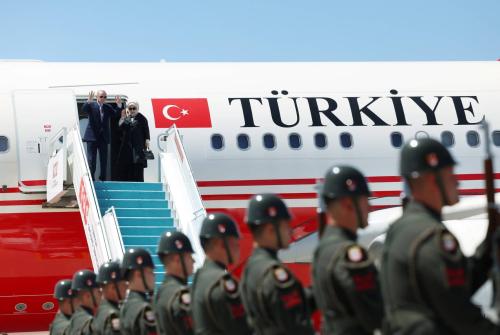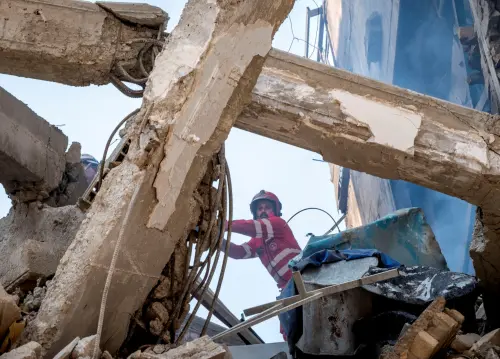The day after P5+1 (the United States, Britain, France, Russia, China and Germany, along with the European Union) and Iranian negotiators reached an interim agreement regarding Iran’s nuclear program, Russian Foreign Minister Sergey Lavrov told the press that implementation of the agreement would make the planned deployment of U.S. SM-3 missile interceptors in Romania and Poland unnecessary.
Perhaps — the SM-3 deployments are to be made as part of the European phased adaptive approach (EPAA) to missile defense. But the United States and NATO would need time, considerable time, before making a decision along the lines that Mr. Lavrov suggests.
The Russian foreign minister based his remark on the fact that NATO’s primary justification for the EPAA has been the threat of Iranian ballistic missiles. Iran has ballistic missiles that can hit targets 1600 kilometers away, including Turkey. It has also tested, but not yet deployed, a ballistic missile with a range of 2200 kilometers, capable of reaching into southeastern Europe.
NATO worries in particular about Iran’s future potential to combine a nuclear warhead with a ballistic missile. Under phase 1 of the EPAA, shipboard SM-3 missile interceptors in the eastern Mediterranean Sea provide a capability to defend against current Iranian ballistic missiles. The planned deployments in Romania in 2015 (phase 2) and Poland in 2018 (phase 3) envisage more capable SM-3 interceptors, including with the ability to engage longer-range Iranian missiles.
The first and obvious response to Mr. Lavrov is that no one yet knows for certain whether the P5+1 and Iran will succeed in reaching a final settlement regarding Iran’s nuclear program. The November 24 agreement was a very positive step. It was only an interim step, however, and the negotiators still face tough issues amidst a considerable degree of mistrust.
In the end, an agreement acceptable to Tehran would almost certainly leave Iran with some uranium enrichment capacity, albeit tightly constrained and under close monitoring by the International Atomic Energy Agency. That would leave a latent nuclear weapons breakout capability. The shorter the time it would take for Iran to exercise a breakout scenario, the more likely that NATO would see missile defense as a useful hedge. The longer the time, the less necessary a missile defense capability against Iran might be.
The P5+1 dialogue with Iran does not address ballistic missiles. If, as part of a settlement of broader differences with Tehran, the Iranians were to cease developing longer-range missiles, that also could undermine the Iran argument for EPAA phases 2 and 3.
This question would only be considered at some point down the road. But if there is a significant walk-back of Iran’s nuclear program (and of its ballistic missile program), questions will naturally arise about the logic for phases 2 and 3. The fact is that, other than Iran, no state near NATO poses a ballistic missile threat to the Alliance — with the exception of Russia. But the SM-3 interceptors to be deployed in phases 2 and 3 will be capable of engaging only medium- and intermediate-range ballistic missiles, which Russia has given up under the terms of the 1987 Intermediate-Range Nuclear Forces Treaty.
To be sure, Iran might continue its ballistic missile program, arming the missiles with conventional warheads. Those, however, would be of far less concern to NATO if the Iranian nuclear program were reliably limited.
So, an Iran settlement could lead to questioning the rationale for going forward with the EPAA. After all, the phased adaptive approach from the beginning implicitly included the notion that the level of missile defense effort could be adjusted downward as well as upward, depending on the assessment of the threat. If there is no serious threat, it makes little sense for the United States and NATO to spend precious defense dollars to deploy SM-3 interceptor missiles in Europe that would have no targets. But it is not yet the slam-dunk call that Mr. Lavrov suggested.
Were Washington and NATO to consider this, they would have to weigh one very important political angle: the need to assure allies — particularly allies in Central Europe who feel more exposed — of the continuing U.S. security commitment to the Alliance.
This would be a particularly tricky question for the Obama administration. While its September 2009 decision to reconfigure missile defense in Europe to the EPAA was correct in substance, the administration terribly mismanaged the rollout, providing no real advance consultations with allies. Understandably, the allies were not amused.
The administration handled the March 2013 decision to cancel phase 4 of the EPAA better. It nevertheless left some allies wondering whether Washington was making decisions regarding their security without taking account of their views.
If developments with and in Iran create the possibility to reconsider the EPAA — still a big if — Washington would want to engage allies early in a consultative process. In that case, Poland and Romania might seek some other U.S. deployment if phases 2 and/or 3 were to be scrubbed. Neither seems to worry about an Iranian missile attack; what interests them most is the presence of the small U.S. military detachments that would deploy to their territory to operate the SM-3s.
Washington would in that case be wise to carefully consider whether and how it might replace the SM-3 deployments. Some limited U.S. conventional capabilities (and U.S. troops) could play the assurance role. They might even contribute to reducing the need that Central European allies now see for keeping U.S. non-strategic nuclear weapons in Europe.
What could the U.S. military deploy to Poland and Romania? That would have to be worked out. The Polish military is interested in Patriot air defense missiles, and the U.S. Army has deployed a training battery to Poland for exercises. That kind of capability would be small, clearly defensive and very likely of interest to both Poland and Romania. It could smooth any decision to alter the EPAA and provide visible assurance of the U.S. security commitment.
The irony is that if things played out this way, it would mean cancelling the deployment of SM-3 missile interceptors, which are too slow to engage Russian strategic ballistic missiles, and deploying in their place U.S. Patriot batteries that would put some very credible air defense capability in Central Europe. Mr. Lavrov might want to think about what he wishes for.
The Brookings Institution is committed to quality, independence, and impact.
We are supported by a diverse array of funders. In line with our values and policies, each Brookings publication represents the sole views of its author(s).



Commentary
Would an Iran Deal Obviate Missile Defense in Europe?
December 2, 2013